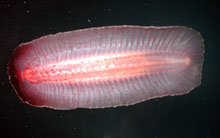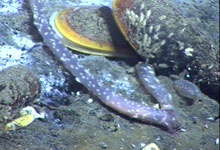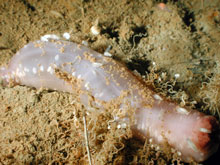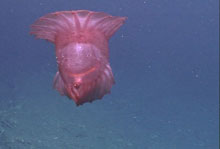The underside of one of the most prevalent deep-sea holothuriods, Benthodytes. The body of this sea cucumber is made of a transparent purple gel. Click image for larger view and image credit.
Chiridota heheva is a legless and especially worm-like holothuroid that we have found in mussel communities below 2,000 meters. Click image for larger view and image credit.
The Kingdom of the Echinoderm
June 18, 2007
Bob Carney
Louisiana State University
26° 41.17 N
91° 39.59 W
![]() Scientists discover a swimming sea cucumber evolved from benthic animals that feed upon the sediment. (Quicktime, 1.4 Mb.)
Scientists discover a swimming sea cucumber evolved from benthic animals that feed upon the sediment. (Quicktime, 1.4 Mb.)
As the remotely operated vehicle (ROV) Jason approaches the carbonate slab islands that denote past (and possibly ongoing) hydrocarbon seepage, its cameras reveal a very different surrounding mud-bottom environment. Benthic ecologists divide this vast sedimentary environment into a margin portion that stretches from the edge of the continental shelf at about 200 meter (m) depth, to the base of the slope at about 3,000 m in the Gulf of Mexico. Beyond and deeper is the abyssal plain, the largest surface habitat on Earth, stretching across all ocean basins between continents. Dark, cold, and experiencing great water pressure, the margin and plain are inhabited by animals quite different from the familiar species found in shallow water.
With the advent of deep-sea photography in the 1950s, the deep bottom was quickly dubbed “The Kingdom of the Echinoderm” due to the relative abundance of species in this phylum, which is usually characterized by a pentamerous (five-way) symmetry and spiny skin. Certainly, many echinoderms such as seastars, brittle stars, sea urchins, and even the ancient crinoids (sea lilies) are found in deep environments. The most common of all deep-sea animals, however, are the quite atypical echinoderms. In our investigation of seeps, we encounter Mesothuria lactea, a large white holothuroid found above 1,500 m. At greater depths, we find even more abundant purple holothuroids in the genera Benthodytes, Psychropodes, and Benthothuria.
Two other species are especially unusual. Specimens of the genus Enypniastes swim so gracefully above the mud bottom that they are easily confused with jellyfish. That misidentification ends suddenly when the animal settles to bottom for a quick meal of sediment before swimming off again. Abundant on the mud bottom, only one holothuroid is known to enter the seep environment. Chiridota heheva is a legless and especially worm-like holothuroid that we have found in mussel communities below 2,000 m. Also found amid the decaying timbers of deep shipwrecks, it seems to specialize on organic-rich habitats.
Why are holothuroids considered atypical echinoderms, and why are they so diverse and oddly adapted in the deep sea? Only the first question has a quick answer. Holothuroids, sometimes called sea cucumbers because of the shape of a few shallow species, are neither pentaradial or spiny skinned. They do have five muscle bands and five rows of podia (feet), but they are otherwise bilateral (like most animals). The bodywall is soft and all that can be found of a spiny skeleton is microscopic calcite particles in the skin. Their success in the deep sea is harder to understand. They feed on organic material in sediment, which is one of the few food sources available very deep. They must, however, be very efficient in finding the most nutritious sediment and utilizing that food fully.
A close-up view of a Chirodota heheva in a recently discovered pogonophoran (worm-like invertebrate) field. The small, white, flea-like organisms covering this individual are amphipods, called "scuds." Click image for larger view and image credit.
The pelagic sea cucumber, Enypniastes, swims so gracefully above the mud bottom that it is often confused with jellyfish. Click image for larger view and image credit.
One intriguing possibility about deep adaptation is the nature of the body wall. Deep holothurians have very gelatinous bodies. Freshly collected by Jason, the bodies are quite stiff and strong. An amazing property of these holothuroid gels is that these animals seem able to adjust their buoyancy at will. Sometimes they float off bottom; sometimes they sink. Could it be, perhaps, that this type of motion allows searches for food that require very little energy? Designers of submersibles, submarines, and ROVs would certainly like to control buoyancy in such a seemingly simple manner. Careful study of all adaptations to live in the deep sea will definitely help manage this threatened environment, and it just might help us more effectively explore and live within the ocean realm.
For now, unfortunately, there isn’t enough time or equipment to explore all the adaptations of these deep dwelling animals; we remain focused on seeps. Does the chemosynthetic production from seeps help feed holothuroids and other fauna out on the food-poor mud bottom? Employing stable carbon and nitrogen isotopes, the holothuroids collected during this expedition will be examined for any indication that some percentage of their nutrition is seep derived.



































